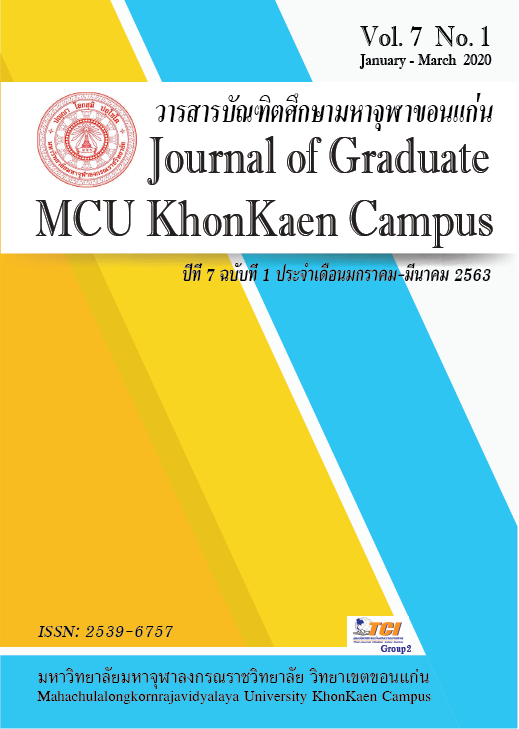WORSHIP: IDENTITY OF THAI SOCIETIES
Main Article Content
Abstract
Belief, thinking and feeling in the human society have all developed into traditions which have been past down from previous generations. These traditions appear to protect individuals from any fears in their lives which grow from belief in superstitions. In order to protect their own safety, they arrange the "worship". The result is that the worship has a strong influence on the human life that can create belief, faith and religion. Each group will establish trust and adhere in their own beliefs which they think it is the right idea However, belief may lead the believer to an undereducated way of life. This can obstruct the believer to havea clear consideration of all perspectivies of life including the fundamentals of logic in humanity Nowadays, there are various problem in the society such as violence, family-disfunction and drugs because their lack of the right way to worship that refuse to see the value and importance in each other. The society must lead people to the right way to worship which should reflect a peaceful and secure like worship as seen in the way of Buddhism. One must teach people to worship the valued individual or obiect in order to learn the value of them. The interaction between each other in society no matter human or object in the right way can create the good example for people in society. The worship must show the sincere form of both body language and the verbal in order to see each other's kindness
Thai society should lead people to act in the "right worship" regulation by teaching the worship and respectful manner in themselves that will lead to developing their life in a way that sees the good in people, doing their own duty, obeying the law and living in social tradition.
Article Details
References
จำนงค์ ทองประเสริฐ. (2539). ปรัชญาประยุกต์ ชุดอินเดีย. กรุงเทพมหานคร : ต้นอ้อ จำกัด.
จำนงค์ อดิวัฒนสิทธิ์. ทรรศนะเชิงพุทธเกี่ยวกับประชากรศาสตร์ใน สังคมวิทยาตามแนวพุทธศาสตร์, รวบรวมและจัดพิมพ์โดย สำนักงานคณะกรรมการวัฒนธรรมแห่งชาติ กระทรวงศึกษาธิการ กรุงเทพมหานคร : สำนักงานคณะกรรมการวัฒนธรรมแห่งชาติ กระทรวงศึกษาธิการจัดพิมพ์, ม.ป.ป
พระธรรมปิฎก (ป.อ. ปยุตฺโต). (2538). พจนานุกรม ฉบับประมวลศัพท์. กรุงเทพมหานคร : มหาจุฬาลงกรณราชวิทยาลัย.
พระมหามานพ เจือจันทร์. (2540). การบูชายัญในพระไตรปิฎก. วิทยานิพนธ์ปริญญาอักษรศาสตรมหาบัณฑิต, บัณฑิตวิทยาลัย : จุฬาลงกรณ์มหาวิทยาลัย.
พระอุดรคณาธิการ (ชวินทร์สระคำ). (2534). ประวัติศาสตร์พุทธศาสนาในอินเดีย. กรุงเทพมหานคร : โรงพิมพ์มหาจุฬาลงกรณราชวิทยาลัย.
มหามกุฏราชวิทยาลัย. (2533). มังคลัตถทีปนี แปล เล่ม 3. กรุงเทพมหานคร : มหามกุฏราชวิทยาลัย.
มาณพ นักการเรียน. (2546). พระพุทธศาสนากับสิ่งแดล้อมศึกษา. กรุงเทพมหานคร :
โรงพิมพ์มหาจุฬาลงกรณราชวิทยาลัย.
ราชบัณฑิตยสถาน. (2539). พจนานุกรมฉบับราชบัณฑิตยสถาน พ.ศ.2525. กรุงเทพมหานคร : อักษรเจริญทัศน์.
สาวิตรี เจริญพงศ์. (2544). อินเดียตั้งแต่สมัยโบราณถึงหลังได้รับเอกราช. กรุงเทพมหานคร: สำนักพิมพ์จุฬาลงกรณ์มหาวิทาลัย.
สุชีพ ปุญญานุภาพ. (2541). คุณลักษณะพิเศษแห่งพระพุทธศาสนา. กรุงเทพมหานคร : มหามกุฏราชวิทยาลัย.
สุชีพ ปุญญานุภาพ. (2541). พระไตรปิฎกฉบับประชาชน. กรุงเทพมหานคร : มหามกุฏราชวิทยาลัย.
สุเชาวน์ พลอยชุม. (2529). สารานุกรมพระพุทธศาสนา. ประมวลจากพระนิพนธ์สมเด็จพระมหาสมณเจ้ากรมพระยาวชิรญาณวโรรส, กรุงเทพมหานคร : มหามกุฏราชวิทยาลัย.
เสฐียร พันธรังสี. (2534). ศาสนาโบราณ. กรุงเทพมหานคร : มหาจุฬาลงกรณ์ราชวิทยาลัย.
______. (2539). พัฒนาการทางวัฒนธรรมไทย. กรุงเทพมหานคร : โรงพิมพ์มหาจุฬาลงกรณราชวิทยาลัย.
______. (2542). พุทธธรรม. กรุงเทพมหานคร : มหาจุฬาลงกรณราชวิทยาลัย.
______. (2542). ศัพท์ศาสนาสากล อังกฤษ – ไทย. กรุงเทพมหานคร : ราชบัณฑิตยสถาน.

